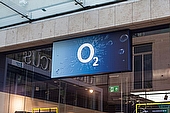In the first quarter of the 2018 financial year, Chinese company Huawei sold more handsets worldwide than Apple, putting them in second place in terms of market share, just behind Samsung.
Much of their success has been attributed to the launch of their flagship handsets, the P20 and the P20 Pro, both of which have proved highly popular in Western markets, as well as in their already established home turf of Asia.
At around the same time as the P20 Pro was hitting our high streets, Samsung launched their latest flagship phone - the Galaxy S9. The latest in a long line of highly successful and internationally popular handsets, the world was excited to see what Samsung would come up with next.

However, the S9 has been referred to as more of an S8.1, with little improvement over it's predecessor. The P20 Pro, on the other hand, has been hailed as a breakthrough in smartphone technology, particularly in terms of the exceptional onboard cameras. Yes, cameras.
We're going to put these two rivals head to head to see which one comes out on top. Who really is the better Android smartphone; the Samsung Galaxy S9 or the Huawei P20 Pro? Let's find out.
At a glance
| Huawei P20 Pro | Samsung Galaxy S9 | |
|---|---|---|
| Price | £625 - £799 | 569 - £739 |
| Weight | 180g | 163g |
| Dimensions | 155 x 73.9 x 7.8mm | 147 x 68.7 x 8.5mm |
| OS | Android 8.1 | Android 8.1 |
| Screen size | 6.1 inch | 5.8 inch |
| Resolution | 1080 x 2240 | 1080 x 2220 |
| CPU | Kirin 970 | Snapdragon 845 / Exynos 9810 |
| RAM | 6GB | 4GB |
| Storage (internal) | 128GB | 64GB |
| Storage (external) | None | MicroSD up to 400GB |
| Battery | 4,000 mAh | 3,000 mAh |
| Rear camera | 40MP + 20MP + 8MP | 12MP |
| Front camera | 24MP | 8MP |
Which is best: The P20 Pro or the Samsung S9
Winner: Huawei P20 Pro - It was a close call, but we had to call it.
Choosing the best smartphone, or best anything for that matter, often comes down to a personal opinion. You have to consider what you personally want from that phone, and how you plan to use it.
The differences in performance, design and many of the functions are so slim between these two phones, it's very difficult to say clearly that one is 'better' than the other.
The Samsung processor is slightly faster, but the P20s RAM is larger. The P20 Pro's battery lasts longer, but the Samsung's screen is slightly better.
In the end, it all comes down to personal preference. For us, we rely on our phones as a camera so much, the superior camera and battery life of the P20 Pro won it for us.
Although the price point of the Huawei tends to be slightly higher, we think it's a reasonable investment to make in balance of the advantages it brings.
However, you may think that for £60 less and a better screen, it's better for you to stick with the big brand you know and love. In the end, it's up to you, but we'll talk you through some of the main differences, so you can make an informed choice.
Price
Winner: Samsung S9 - it's generally around £60 - £65 cheaper than the P20 Pro.
Although both handsets had a release price north of £700, now that they've both been out for a little while, we starting to see prices falling. Eagle eyed bargain hunters will be able to spot both handsets for well under the original price.
The Samsung was originally priced slightly lower, at £739 compared to the P20 Pro at £799, and that trend is continuing. The lowest we've seen it for sale from a major UK retailer is £569, still around £65 cheaper than the cheapest P20 Pro we've spotted.
As with anything, occasional special deals and flash sales may bring these prices down even further, so it's worth shopping around if you're in the market for either phone. However, on the prices as they are today, the Samsung wins it.
Audio
Winner: Samsung Galaxy S9 - Both phones have quality on board audio, but the lack of a headphone jack on the P20 Pro is just a step too far for us.
Both phones offer support for Dolby Atmos, which gives a bigger, more spacious sound to the speaker output. Both also use improved speakers, with one at the bottom and one by the earpiece for a genuine stereo output.
One consideration for the P20 Pro is the fact there is no headphone jack socket. Users will need to either go for a Bluetooth connection for headphones or buy a dongle to connect audio via the USB-C port. The S9, on the other hand, has a standard headphone port.
Both handsets come with included headphones, but where the S9 ones are a relatively high quality pair of AKG headphones, the supplied set from Huawei are somewhat basic, and would probably need replacing if you love a good quality sound.
Overall, the flexibility of the S9 gives it the edge for us. Although Apple are doing away with headphone sockets, we don't really see a reason for other brands to mimic this; we like being able to plug in and go!
Display
Winner: Samsung Galaxy S9 - More PPI, Full HD streaming support and that glorious infinity edge; what's not to love?
On the Samsung, you'll be looking at a slightly curved 5.8 inch quad HD curved super AMOLED screen, with a ratio of 18:5:9 and 568ppi. Sound familiar? It should. It's the exact same screen they used in the S8.
Samsung obviously realised they got it right in the S8, and saw little reason to change it, and we have to agree. The screen on the S9 is still gorgeously colourful, lovely and bright and one of the best displays in the industry.
The P20 Pro's screen is slightly larger at 6.1 inches but has a lower pixel density of 408ppi. Its not a difference you'd notice immediately, but the overall image quality on the P20 will be harder to maintain than on the S9.
Both phones offer customisable colour profiles, with the P20 also capable of altering its colour gamut on the fly, based on the environment it's in. The one big difference, which could be a deal breaker for some, is the lack of support for HD content from Netflix on the P20 Pro.
Streaming from Netflix in anything over 480p is not possible at this time on the Huawei model. The quality of the screen will probably make it feel more like 720p, but for small screen cinephiles, this is going to be a crucial problem.
In many ways, the screen on the Samsung is superior to that on the P20 Pro, and while most of us would barely notice the difference, it's important to recognise greatness when it is, indeed, great.
Design
Winner: Huawei P20 Pro - Both handsets are good looking models, but the P20 Pro has the edge for us.
We like the look of both these phones, but in terms of wow factor and new design, it's hard not to love the P20 Pro. The expanse of glass with the brushed aluminium edging gives it a sparkle that's definitely eye catching.
Its slim profile makes it look super modern and beats the Samsung by almost a whole millimetre. Available in blue, black or a beautiful purple to turquoise gradient version, it offers a unique design that couldn't be mistaken for anything else.
The Samsung, on the other hand, is more of a reworked S8 than anything particularly new and exciting. It's ever so slightly shorter, very slightly fatter and a tad heavier than its predecessor, but nothing that you'd notice without reading the specs.
The S8 was a beautiful design, and the S9 maintains all the beauty and elegance of it's older brother. However, when you're investing in the latest phone, it's kind of nice to have something obviously new in your hand.
The only downside to the design of the P20 Pro is the little notch at the top of the screen. This is something we've seen on the newer iPhones and the Pixel 3 and seems to be something of a trend right now. Love it or hate it, we don't feel it detracts from the overall attractiveness of this handset.
Camera
Winner: Huawei P20 Pro - Samsung made a good camera, but Huawei made an excellent one.
The camera is where these two phones really go head to head. Both claim to have improved the camera tech to take phone photography to another level, but who's really come up with a winner?
The S9 was launched with the strapline 'The Camera. Reimagined.' so we were expecting great thing from this device. However, the reality has turned out to be something of a let-down, with no dual camera as we'd all been hoping.
The S9s camera is certainly improved, but it's still at just 12MP. The main upgrade is the dual aperture function, which automatically adjusts the aperture to let in more or less light, depending on the conditions. It's one of the fastest lenses of any phone on the market, and certainly improves the outcome of low light photography.
However, despite all Samsungs best efforts to 'reimagine' the camera, Huawei has gone just a little bit further. Not content with offering a dual camera on the rear for better quality shots, they went ahead and added three. The main sensor offers 40MP, with a black and white 20MP lens and a 3x zoom 8MP one too.
The effect of all these different lenses is clear to see. Without using any digital zoom, it's possible to shoot at a truly impressive level of magnification with no loss of quality. The low light photography is, without doubt, the very best ever seen from a smartphone, thanks to the in built 'night mode' that just fixes everything for you.
For front cameras, the Huawei wins again. Samsung's 8MP front shooter is good, the P20 Pro's is simply much better. With 24MP on the camera, it's four times as detailed and four times the quality of the S9, so your selfies can look better than ever.
Battery
Winner: Huawei P20 Pro - Although it doesn't support wireless charging, the two day long batter life wins it for us.
Samsung didn't to anything to upgrade the batter from the S8, which is a bit of a disappointment. Staying at 3,000 mAh means it would last the average user around a day, maybe a little longer if you're a really light user.
The P20 Pro has a larger battery at 4,000 mAh, which promises to have a lifespan of 36 - 48 hours during normal use. That's massive! Its included fast charger will take it from empty to full in just over an hour and a half, and from 0 - 80% in just 45 minutes.
On the downside, the P20 Pro does not support wireless charging, which is a bit of a let down on such a modern phone. The S9 does, and promises fast wireless charging, although you'll always get better charging speeds when its plugged in.
Unless you've been used to using wireless charging, however, we don't think you'll really miss this feature. For that reason, the extensive life of the P20 Pro's battery just pips it for us.
Performance
Winner: Samsung S9 - They're almost evenly matched for performance, but the S9 just has the edge in terms of processor speed.
The Samsung Galaxy S9 might not look very different to the S8, but it's had some notable tweaks under the bonnet. The new processor is the Exynos 9810 chip, which while still an octa-core processor boasts better speeds than those in the S8, taking its speed from 2.4 to 2.7GHz.
In some markets, Samsung are releasing the S9 with a Snapdragon 845, the same processor found in the Xperia XZ2, the Xiaomi Mi 8 and the Asus Zenfone 5Z. However, in the UK market your much more likely to come across the Exynos chipset. Either way, both deliver the same blistering speeds and high performance capacity, with the Exynos slightly having the edge.
In the P20 Pro, you've got a Kirin 970 CPU running at 2.4GHz. This makes it slower than the S9, although slightly faster than the S8. The difference, however, is relatively minimal, and you're unlikely to notice any difference in general use of either phone; both are more than capable of running all the apps and games currently available for mobile.
One big difference between the two is the RAM on board. The P20 Pro has a whopping 6GB of RAM backed up with 128GB of internal storage. For the S9, it's just 4GB of RAM and 64GB of storage. However, there is some debate over whether the extra 2GB of RAM really makes any difference to the performance of the phone, or whether it just makes it look good on paper.
The onboard memory in the P20 Pro might be appealing at first, but the big downside here is that there's no option for a microSD card to be added later. The S9, on the other hand, has a slot for a microSD card, which can take up to 400GB of additional storage.
In terms of physical speed and under the hood technology, there's probably not enough of a difference to really affect the user experience. However, as we have to pick a winner, we're going for the Samsung based on that powerful Exynos CPU.
Summary
Winner: P20 Pro - We think the extra investment is worth it for that huge battery life, the amazing camera and to break free from the Samsung swamped world of the smartphone.
Having had a good look at both handsets, the differences really are as thin as a piece of paper. On the one hand, Samsung has the reputation and the brand desirability, not to mention that beautiful screen. On the other, this newcomer has really stepped things up a gear in terms of the on board camera, and that battery life is just incredible.
The decision about which phone is right for you will come down to what you like doing and how you want to spend your time. If you rely on your smartphone as your main camera, the P20 Pro has an awful lot to offer in terms of improving your family snaps.
However, if you spend a lot of time watching video content on your device, the screen and full HD streaming support on the S9 is going to be a winner for you.
For us, we like a phone that's a good all-rounder, and we have a penchant for supporting the underdog too. We also think that, when you're investing in a new smartphone, you want to get something new. The S9 is just too close to the S8 to make it worth the upgrade.
For this reason, we've picked the P20 Pro as our handset winner. It's a few pounds more expensive, but we really feel it's stepped out of the box both in terms of design and functionality.
Compare prices for the Huawei P20 Pro or the Samsung Galaxy S9 on our mobile handset comparison page.









Comments (1)